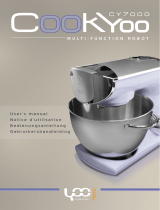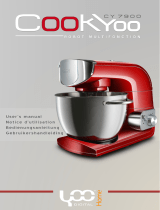1
English
IMPORTANT SAFEGUARDS
When using electrical appliances, basic
safety precautions should always be
followed including the following:
1. Read all instructions.
2. To protect against risk of
electrical shock, do not put Stand
Mixer in water or other liquid.
3. Close supervision is necessary
when any appliance is used by or
near children.
4. Unplug Stand Mixer from outlet
when not in use, before putting
on or taking off parts and before
cleaning.
5. Avoid contacting moving parts.
Keep hands, hair, clothing, as
well as spatulas and other
utensils away from beater during
operation to reduce the risk of
injury to persons and/or damage
to the Stand Mixer.
6. Do not operate Stand Mixer with
a damaged cord or plug or after
the Stand Mixer malfunctions, or
is dropped or damaged in any
manner. Return appliance to the
nearest Authorized Service Center
for examination, repair or electrical
or mechanical adjustment.
7. The use of attachments not
recommended or sold by
KitchenAid may cause fire,
electrical shock or injury.
8. Do not use the Stand Mixer
outdoors.
9. Do not let the cord hang over
edge of table or counter.
10. Remove flat beater, wire whip or
dough hook from Stand Mixer
before washing.
11. This product is designed for
household use only.
12. The appliance is not intended for
use by young children or infirm
persons without supervision.
13. Young children should be
supervised to ensure that they do
not play with the appliance.
SAVE THESE INSTRUCTIONS
This appliance is marked according to
the European directive 2002/96/EC on
Waste Electrical and Electronic
Equipment (WEEE).
By ensuring this product is disposed
of correctly, you will help prevent
potential negative consequences for
the environment and human health,
which could otherwise be caused by
inappropriate waste handling of this
product.
The symbol on the product, or
on the documents accompanying the
product, indicates that this appliance
may not be treated as household
waste. Instead it shall be handed over
to the applicable collection point for
the recycling of electrical and
electronic equipment.
Disposal must be carried out in
accordance with local environmental
regulations for waste disposal.
For more detailed information about
treatment, recovery and recycling of
this product, please contact your local
city office, your household waste
disposal service or the shop where you
purchased the product.























